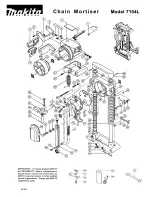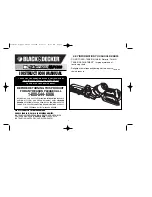
20
GB
Blade guard assembly, Fig. 4
Install the blade guard to the holder as shown in the
diagram. Secure the screws with a nut and washer.
• Lift the saw onto the frame and base and push it
onto the workbench.
• Familiarize yourself with the saw operating ele-
ments and features.
Mounting the saw on a work bench, Fig. 5
• A workbench made from solid wood is betier than
one made of plywood, as interfering vibrations and
noise are more noticeable with plywood.
• The necessary tools and small parts for assem-
bling the saw on a workbench are not supplied
with the saw. However, use equipment of at least
the following size:
E Saw body
F Foam rubber base
GWork bench
H Flat seal
I Washer
J Hexagonal nut
K Lock nut
L Hexagonal bolt
Ouantity Description
4 Hexagonal bolts (6mm) 1/4-20 x length
4 Flat seal (7mm) 9/321.0
4 Washers (7mm) 9/321.0.
8 Hexagonal nuts (6 mm) 1/4-20
First of all, drill holes into the seating surface and
then insert the screws.
• A foam rubber base for reduction of noise is not
supplied with the saw either. However, we express-
ly recommend that you use such a base to keep
vibration and noise to a minimum. Ideal size 400
x 240 mm.
Changing the saw blades
Warning: Switch off the saw and remove the mains
supply plug before installing saw b!ades in order to
avoid injuries caused by unintentiona! activation of
the saw.
A. Flat saw-blades Fig. 6
Use the adapter with flat saw-blades.
The saw-blade is fixed with Allen screws.
A 1 Saw-blade removal, fig. 7+8, 10
• Extract the saw-blade by sliding the table’s inlay
up, then unscrew the tightening screw (1).
• Slightly press the upper arm (M) down
(fig. 10)
.
• Then remove the sawblade by pulling it forward out
of the supports and through the access perfora-
tion in the table.
A 2 Inserting the saw-blade:
• Put the saw-blade with the two adapters into the
lower support, the other end into the upper sup-
port.
• Slightly press the upper arm (M) down
(fig 10)
be-
fore hooking it in.
• Tighten the blade with the tightening screw (1)
(fig.7)
by rotating it clockwise. Check the tightness
of the blade. Keep on rotating clockwise in order
to tighten the blade even more.
B. Saw-blade with pins
B 1 Saw blade removal, fig. 7 + 8
•
Extract the saw-blade by first unscrewing the tight
-
ening screw (1).
• Remove the saw-blade from the upper and lower
support by slightly pressing the saw´s upper arm
down
(fig. 10, M)
.
B 2 Inserting the saw-blade fig 7, 9-11
• Lead one end of the saw-blade through the per-
foration in the table and insert the saw-blade pins
into the notch. Repeat this procedure at the upper
blade support.
• Before hooking it in, slightly press the saw´s upper
arm down. (Fig 9; Nr. 10)
• Check the position of the blade pins at the sup-
ports
(fig 11)
.
• Tighten the blade by means of the tightening
screw. Check the blade´s tightness. Keep on ro-
tating clockwise in order to tighten the blade even
more. (Fig. 7).
8. Operation
A scroll saw is fundamentally a „curve cutting tool“
but which can also carry out straight and angled
edge cuts. Familiarise yourself with the following im-
portant points prior to commissioning the saw.
• The saw does not automatically cut wood. You
must feed the wood against the saw blade manu-
ally.
• The cutting process occurs on I y while the blade
is moving downwards.
• Feed the wood slowly against the saw blade as
the saw blade teeth are small and cut only while
moving downwards.
• AlI persons carrying out work with the saw require
training. The saw blade may break easily during
this training time Iwhile the operator is sti1l unfa-
miliar with the saw.
• The saw is best suited tor sheets of wood less than
2.5 cm thick.
• Feed the wood especially slowly against the blade
and avoid abrupt curves to prevent the saw blade
from breaking, if you wish to cut wood sheets thick-
erthan 2.5 cm.
• Saw blade teeth blunten over time, saw blades
must be replaced. The saw blades are sufficient
tor 1/2 to 2 operating time depending upon the
type of wood.
• Try and make sure that the saw blade follows the
grain of the wood in order to obtain a clean cut.
• The saw speed must be reduced to minimum when
cutting precious and non-terrous metals.
Inside cuts
Warning: Switch off the saw and remove the mains
supply plug before installing saw blades in order to
avoid injuries caused by unintentional activation of
the saw.
This saw is suited also to inside cuts cuts not starting
at the edge of the work piece. Proceed as follows:
• Drill a 6 mm hole in the work piece.
• Loosen the blade tension er and release the ten-
sion in the blade.
• Place the bore hole over the saw blade slot in the
















































